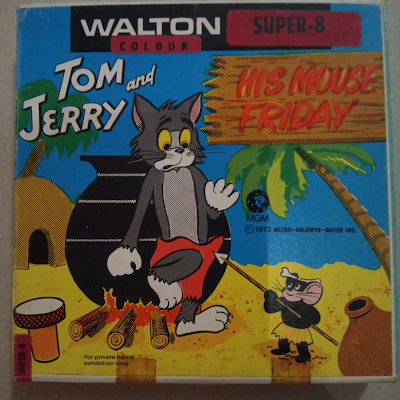
This short film marked the second screen appearance of Spike the bulldog's young son Tyke. The character had not appeared in a cartoon since Love That Pup (1949) and wouldn't appear again until That's My Pup! (1953). Like in his previous film he does not talk here, only letting out a few barks. He would not gain the ability to use words until 1990 with TV's Tom & Jerry Kids Show (a delightful and underrated TV series). This cartoon however did feature a slight change in both Tyke and Spike. This is a change in color. The two go from the light gray they were in their previous cartoon (or cartoons in the case of Spike) to what the Tom and Jerry Wiki refers to as "creamy-tan." They would remain this color for the rest of their career in theatrical shorts but would revert back to their original color in Tom and Jerry Kids Show.
In this short film Tom accidently gets Tyke dirty as he is chasing Jerry. This makes Spike very angry. Spike tells Tom that he is stepping out for a bit but if Tyke is messy when he comes back, he will pulverize the poor cat. Unfortunately for Tom, Jerry overhears this and sees it as the perfect opportunity to get back at his foe. Jerry does everything he can to get Tyke messy, while Tom does all he can to clean Tyke up.
This may not be the most original story with the idea of Tom having to keep something (or in this case someone) clean or else having been done a few years earlier in Mouse Cleaning (1948). However with Tom and Jerry the point is never the originality of the premise but rather the execution. Luckily the execution is wonderful here. Like always the best laughs don't come from the gags themselves but rather the great character animation. The character animation couldn't be better here. Jerry tricking Tom into playing a game of Tic-Tac-Toe on Tyke's body is a standard cartoon gag. However watching Tom carefully thinking about his next move and being so delighted with himself after doing it is hilarious. The same is true of his brief pride from winning the game of Tic-Tac-Toe before he realizes what he has done. Once again without saying a word Tom is one of the most expressive cartoon characters out there and he always feels completely real to us. This cartoon also features a truly clever extended gag at the end with Tom trying to disguise Tyke as a chicken. The sheer ridiculousness of this gag and the idea that anyone would be fooled is laugh out loud funny. This film also benefits from a wonderful score by Scott Bradley. While Scott Bradley's music is always wonderful, this is an especially lively and fun score.
The credited animators on this cartoon include Ed Barge, Kenneth Muse, Irven Spence and Ray Patterson. This is the 60th Tom and Jerry cartoon overall.
Below is the movie poster for this film.














